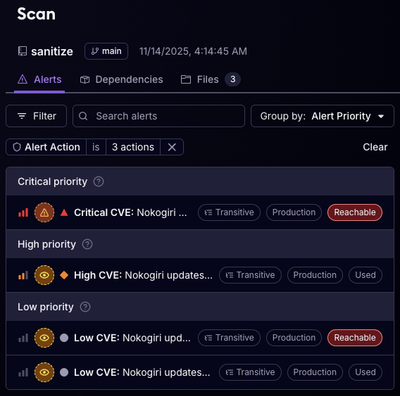
Product
Announcing Bun and vlt Support in Socket
Bringing supply chain security to the next generation of JavaScript package managers
tf-geometric
Advanced tools
Efficient and Friendly Graph Neural Network Library for TensorFlow 1.x and 2.x.
Inspired by rusty1s/pytorch_geometric\ , we build a GNN library for TensorFlow.
https://github.com/CrawlScript/tf_geometric <https://github.com/CrawlScript/tf_geometric>_https://tf-geometric.readthedocs.io <https://tf-geometric.readthedocs.io>_ (\ 中文版 <https://tf-geometric.readthedocs.io/en/latest/index_cn.html>_\ )Efficient Graph Deep Learning in TensorFlow with tf_geometric <https://arxiv.org/abs/2101.11552>_We use Message Passing mechanism to implement graph neural networks, which is way efficient than the dense matrix based implementations and more friendly than the sparse matrix based ones. In addition, we provide easy and elegant APIs for complex GNN operations. The following example constructs a graph and applies a Multi-head Graph Attention Network (GAT) on it:
.. code-block:: python
import numpy as np import tf_geometric as tfg import tensorflow as tf
graph = tfg.Graph( x=np.random.randn(5, 20), # 5 nodes, 20 features, edge_index=[[0, 0, 1, 3], [1, 2, 2, 1]] # 4 undirected edges )
print("Graph Desc: \n", graph)
graph = graph.to_directed() # pre-process edges print("Processed Graph Desc: \n", graph) print("Processed Edge Index:\n", graph.edge_index)
gat_layer = tfg.layers.GAT(units=4, num_heads=4, activation=tf.nn.relu) output = gat_layer([graph.x, graph.edge_index]) print("Output of GAT: \n", output)
Output:
.. code-block:: html
Graph Desc: Graph Shape: x => (5, 20) edge_index => (2, 4) y => None
Processed Graph Desc: Graph Shape: x => (5, 20) edge_index => (2, 8) y => None
Processed Edge Index: [[0 0 1 1 1 2 2 3] [1 2 0 2 3 0 1 1]]
Output of GAT: tf.Tensor( [[0.22443159 0. 0.58263206 0.32468423] [0.29810357 0. 0.19403605 0.35630274] [0.18071976 0. 0.58263206 0.32468423] [0.36123228 0. 0.88897204 0.450244 ] [0. 0. 0.8013462 0. ]], shape=(5, 4), dtype=float32)
We recommend you to get started with some demo.
Node Classification ^^^^^^^^^^^^^^^^^^^
Graph Convolutional Network (GCN) <demo/demo_gcn.py>_Multi-head Graph Attention Network (GAT) <demo/demo_gat.py>_Approximate Personalized Propagation of Neural Predictions (APPNP) <demo/demo_appnp.py>_Inductive Representation Learning on Large Graphs (GraphSAGE) <demo/demo_graph_sage_func.py>_Convolutional Neural Networks on Graphs with Fast Localized Spectral Filtering (ChebyNet) <demo/demo_chebynet.py>_Simple Graph Convolution (SGC) <demo/demo_sgc.py>_Topology Adaptive Graph Convolutional Network (TAGCN) <demo/demo_tagcn.py>_Deep Graph Infomax (DGI) <demo/demo_dgi.py>_DropEdge: Towards Deep Graph Convolutional Networks on Node Classification (DropEdge) <demo/demo_drop_edge_gcn.py>_Graph Convolutional Networks for Text Classification (TextGCN) <https://github.com/CrawlScript/TensorFlow-TextGCN>_Simple Spectral Graph Convolution (SSGC/S^2GC) <demo/demo_ssgc.py>_Graph Classification ^^^^^^^^^^^^^^^^^^^^
MeanPooling <demo/demo_mean_pool.py>_Graph Isomorphism Network (GIN) <demo/demo_gin.py>_Self-Attention Graph Pooling (SAGPooling) <demo/demo_sag_pool_h.py>_Hierarchical Graph Representation Learning with Differentiable Pooling (DiffPool) <demo/demo_diff_pool.py>_Order Matters: Sequence to Sequence for Sets (Set2Set) <demo/demo_set2set.py>_ASAP: Adaptive Structure Aware Pooling for Learning Hierarchical Graph Representations (ASAP) <demo/demo_asap.py>_An End-to-End Deep Learning Architecture for Graph Classification (SortPool) <demo/demo_sort_pool.py>_Spectral Clustering with Graph Neural Networks for Graph Pooling (MinCutPool) <demo/demo_min_cut_pool.py>_Link Prediction ^^^^^^^^^^^^^^^
Graph Auto-Encoder (GAE) <demo/demo_gae.py>_Save and Load Models ^^^^^^^^^^^^^^^^^^^^
Save and Load Models <demo/demo_save_and_load_model.py>_Save and Load Models with tf.train.Checkpoint <demo/demo_checkpoint.py>_Distributed Training ^^^^^^^^^^^^^^^^^^^^
Distributed GCN for Node Classification <demo/demo_distributed_gcn.py>_Distributed MeanPooling for Graph Classification <demo/demo_distributed_mean_pool.py>_Sparse ^^^^^^
Sparse Node Features <demo/demo_sparse_node_features.py>_Requirements:
Operation System: Windows / Linux / Mac OS
Python: version >= 3.7
Python Packages:
Use one of the following commands below:
.. code-block:: bash
pip install -U tf_geometric # this will not install the tensorflow/tensorflow-gpu package
pip install -U tf_geometric[tf1-cpu] # this will install TensorFlow 1.x CPU version
pip install -U tf_geometric[tf1-gpu] # this will install TensorFlow 1.x GPU version
pip install -U tf_geometric[tf2-cpu] # this will install TensorFlow 2.x CPU version
pip install -U tf_geometric[tf2-gpu] # this will install TensorFlow 2.x GPU version
We provide both OOP and Functional API, with which you can make some cool things.
.. code-block:: python
import os
os.environ["CUDA_VISIBLE_DEVICES"] = "0"
import tf_geometric as tfg import tensorflow as tf import numpy as np
x = np.random.randn(5, 20).astype(np.float32) # 5 nodes, 20 features
convert_edge_to_directed method.edge_index = np.array([ [0, 0, 1, 3], [1, 2, 2, 1] ])
edge_weight = np.array([0.9, 0.8, 0.1, 0.2]).astype(np.float32)
graph = tfg.Graph(x=x, edge_index=edge_index, edge_weight=edge_weight).to_directed()
gcn_layer = tfg.layers.GCN(4, activation=tf.nn.relu)
h = gcn_layer([graph.x, graph.edge_index, graph.edge_weight]) print("Node Representations (GCN on a Graph): \n", h)
for _ in range(10): # Using Graph.cache can avoid recomputation of GCN's normalized adjacency matrix, # which can dramatically improve the efficiency of GCN. h = gcn_layer([graph.x, graph.edge_index, graph.edge_weight], cache=graph.cache)
batch_graph = tfg.BatchGraph.from_graphs([graph, graph, graph, graph, graph])
graphs = batch_graph.to_graphs()
batch_gcn_layer = tfg.layers.GCN(4, activation=tf.nn.relu)
batch_h = gcn_layer([batch_graph.x, batch_graph.edge_index, batch_graph.edge_weight]) print("Node Representations (GCN on a BatchGraph): \n", batch_h)
graph_h = tfg.nn.mean_pool(batch_h, batch_graph.node_graph_index, num_graphs=batch_graph.num_graphs) print("Graph Representations (Mean Pooling on a BatchGraph): \n", batch_h)
gcn_score_layer = tfg.layers.GCN(1)
node_score = gcn_score_layer([batch_graph.x, batch_graph.edge_index, batch_graph.edge_weight]) node_score = tf.reshape(node_score, [-1]) print("Score of Each Node: \n", node_score) topk_node_index = tfg.nn.topk_pool(batch_graph.node_graph_index, node_score, ratio=0.6) print("Top-k Node Index (Top-k Pooling): \n", topk_node_index)
graph, (train_index, valid_index, test_index) = tfg.datasets.CoraDataset().load_data()
train_data, valid_data, test_data = tfg.datasets.PPIDataset().load_data()
graph_dicts = tfg.datasets.TUDataset("NCI1").load_data()
gcn_layer = tfg.layers.GCN(units=20, activation=tf.nn.relu)
for graph in test_data: # Cache can speed-up GCN by caching the normed edge information outputs = gcn_layer([graph.x, graph.edge_index, graph.edge_weight], cache=graph.cache) print(outputs)
gat_layer = tfg.layers.GAT(units=20, activation=tf.nn.relu, num_heads=4) for graph in test_data: outputs = gat_layer([graph.x, graph.edge_index]) print(outputs)
class GCNModel(tf.keras.Model):
def __init__(self, *args, **kwargs):
super().__init__(*args, **kwargs)
self.gcn0 = tfg.layers.GCN(16, activation=tf.nn.relu)
self.gcn1 = tfg.layers.GCN(7)
self.dropout = tf.keras.layers.Dropout(0.5)
def call(self, inputs, training=None, mask=None, cache=None):
x, edge_index, edge_weight = inputs
h = self.dropout(x, training=training)
h = self.gcn0([h, edge_index, edge_weight], cache=cache)
h = self.dropout(h, training=training)
h = self.gcn1([h, edge_index, edge_weight], cache=cache)
return h
gcn_model = GCNModel() for graph in test_data: outputs = gcn_model([graph.x, graph.edge_index, graph.edge_weight], cache=graph.cache) print(outputs)
gcn_w = tf.Variable(tf.random.truncated_normal([test_data[0].num_features, 20])) for graph in test_data: outputs = tfg.nn.gcn(graph.x, graph.adj(), gcn_w, activation=tf.nn.relu) print(outputs)
for graph in test_data: outputs = tfg.nn.aggregate_neighbors( x=graph.x, edge_index=graph.edge_index, edge_weight=graph.edge_weight, mapper=tfg.nn.identity_mapper, reducer=tfg.nn.sum_reducer, updater=tfg.nn.sum_updater ) print(outputs)
If you use tf_geometric in a scientific publication, we would appreciate citations to the following paper:
.. code-block:: html
@inproceedings{DBLP:conf/mm/HuQFWZZX21, author = {Jun Hu and Shengsheng Qian and Quan Fang and Youze Wang and Quan Zhao and Huaiwen Zhang and Changsheng Xu}, editor = {Heng Tao Shen and Yueting Zhuang and John R. Smith and Yang Yang and Pablo Cesar and Florian Metze and Balakrishnan Prabhakaran}, title = {Efficient Graph Deep Learning in TensorFlow with tf{_}geometric}, booktitle = {{MM} '21: {ACM} Multimedia Conference, Virtual Event, China, October 20 - 24, 2021}, pages = {3775--3778}, publisher = {{ACM}}, year = {2021}, url = {https://doi.org/10.1145/3474085.3478322}, doi = {10.1145/3474085.3478322}, timestamp = {Wed, 20 Oct 2021 12:40:01 +0200}, biburl = {https://dblp.org/rec/conf/mm/HuQFWZZX21.bib}, bibsource = {dblp computer science bibliography, https://dblp.org} }
https://github.com/CrawlScript/MIG-GT <https://github.com/CrawlScript/MIG-GT>_.https://github.com/CrawlScript/RpHGNN <https://github.com/CrawlScript/RpHGNN>_.https://github.com/CrawlScript/Torch-MGDCF <https://github.com/CrawlScript/Torch-MGDCF>_.TensorFlow Sparse (tf_sparse) <https://github.com/CrawlScript/tf_sparse>_ to implement efficient and elegant
sparse TensorFlow operations for tf_geometric. URL: https://github.com/CrawlScript/tf_sparse <https://github.com/CrawlScript/tf_sparse>_.GRecX <https://github.com/maenzhier/GRecX>_ is an efficient and unified benchmark for GNN-based recommendation. URL: https://github.com/maenzhier/GRecX <https://github.com/maenzhier/GRecX>_.FAQs
Efficient and Friendly Graph Neural Network Library for TensorFlow 1.x and 2.x.
We found that tf-geometric demonstrated a healthy version release cadence and project activity because the last version was released less than a year ago. It has 1 open source maintainer collaborating on the project.
Did you know?

Socket for GitHub automatically highlights issues in each pull request and monitors the health of all your open source dependencies. Discover the contents of your packages and block harmful activity before you install or update your dependencies.

Product
Bringing supply chain security to the next generation of JavaScript package managers

Product
A safer, faster way to eliminate vulnerabilities without updating dependencies

Product
Reachability analysis for Ruby is now in beta, helping teams identify which vulnerabilities are truly exploitable in their applications.